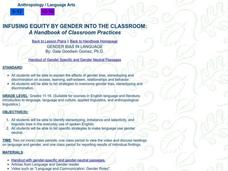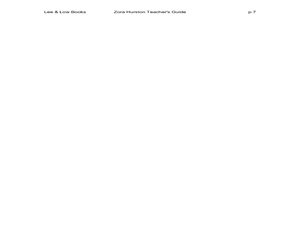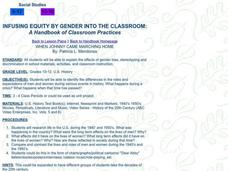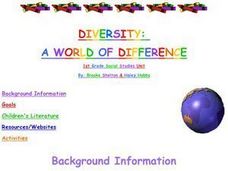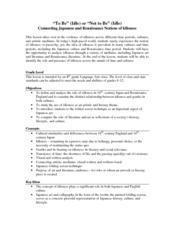Idaho Coalition
The Hunger Games: Gender Empowerment
The odds are in your favor that your pupils will love this lesson that uses The Hunger Games to launch a study of gender empowerment, as well as the influence of social constructs of gender. Groups discuss how Katniss Everdeen and Peeta...
Curated OER
Examining Women's Roles through Primary Sources and Literature
High schoolers interpret historical evidence presented in primary resources. In this women's history lesson, students examine the role of women prior to and following the suffrage movement. High schoolers also read selected pieces of...
Curated OER
Water: The Flow of Women's Work
Learners view photographs, read, and reflect on their own environments to gather information about gender roles in Lesotho and the United States. Students role-play gender role related scenarios and write about their reflections on the...
Curated OER
Women in India: Tradition vs. Modernity
Students explore cultural aspects such as gender roles and their impact on Indian culture and compare and contrast issues associated with those roles in America through literature.
Curated OER
Gender Equity in Fairy Tales
Students explore language arts by researching fairy tale stereotypes. In this gender roles lesson, students read the stories Sleeping Beauty, Little Red Riding Hood, and Snow White with their class. Students analyze the female characters...
EngageNY
Grade 10 ELA Module 4: Unit 2, Lesson 4
Ambition, murder, nontraditional gender roles ... some problems just can't be fixed in marriage counseling. Learners discuss the relationship between Macbeth and Lady Macbeth. As a culminating activity, pupils analyze how the characters'...
Curated OER
The Tale of Genji
Did you know that the world's first novel was written by a woman? Murasaki Shikibu's The Tale of Genji, was published in 1021. Class members research Eastern and Western cultures in the 10th and 11th centuries, view modern adaptations of...
Curated OER
Female Poets Speak For Themselves
Student examine selected works of twentieth-century female poets that speak to the stereotypes about women inherent in Western culture. Individually, students explore these stereotypes and their experience with them. Students create a...
Curated OER
Gender Bias in Language
Twelfth graders study the issues between male and females. In this current events lesson, 12th graders read an article and answer questions. Students watch a video and write an essay.
Curated OER
Racism, Gender, Ethnicity, and Aesthetics in the Art of Graffiti
Students describe how graffiti is a part of everyday culture. They develop basic vocabulary terms for thinking and writing about graffiti and make and justify judgments about aesthetics qualities in graffiti art. They compare and...
Teaching Women's History
Georgian Women
Britain was and is a stratified nation. History sleuths investigate the Georgian Era (1714-1830) of British history to gain an understanding of how the roles women played during this period were influenced by class, race, and religion....
Curated OER
When Johnny Came Marching Home
Students examine the concept of gender bias. In this discrimination lesson, students research 1940's and 1950's America and determine how historical events shaped the changing role of women in the country.
Curated OER
Children's Literature Meets Learning Theories
Students examine learning theories and principles through children's literature. In groups, they select theories and create multimedia presentations exemplifying them. Students discuss the various themes related to human growth,...
Curated OER
A Look At Charlotte's Web
Twelfth graders investigate the social structure of VIctorian England. They research especially the lives of Charlotte Bronte and Jane Eyre. Students create an essay and oral presentation using technology. Then they use the internet to...
National Endowment for the Humanities
Language Analysis Based on Stave 1
Class members meet the original scrooge, the Dickens character whose name has become synonymous with a cold-hearted, tight-fisted, miser. Using the provided worksheet, readers closely examine context clues to determine the meanings of...
Curated OER
The Lion, the Witch, and the Wardrobe: Graphic Organizer: Venn Diagram
Get to know more about the characters of the novel The Lion, the Witch and the Wardrobe by C.S. Lewis by comparing and contrasting their character traits using a Venn diagram.
Curated OER
Zora Hurston Teacher's Guide
Students explore American culture by reading classic literature in class. In this African-American history lesson, students read the story Zora Hurston and the Chinaberry Tree while identifying the work and contributions of the real life...
Curated OER
"Tomorrow and Tomorrow and Tomorrow"
Do you want to live forever? After reading Kurt Vonnegut’s short story, “Tomorrow and Tomorrow and Tomorrow,” class groups adopt the roles of an ethics committee, product manufacturers, concerned scientists, and potential users of an...
Curated OER
WHEN JOHNNY CAME MARCHING HOME
Students examine the roles of men and women throughout history.
Curated OER
Class Distinctions in Art And Literature
Students evaluate the validity of a society where the individual's place is based on such arbitrary norms as gender, family connections, economic status, or military prowess in this look at Asian culture.
Curated OER
Diversity: a World of Difference
First graders each add a different item to a classroom salad while discussing the connection to a multicultural society. They also create a friendship web with yarn by each of them contributing some unique quality about themselves. ...
Curated OER
Getting to Know You
Students complete an getting to know each other activity. In this personal names lesson, students play a name game, read a book about names, and then discuss why names are important. Students design a name card on oak tag rectangles and...
Curated OER
"To Be" (Idle) or "Not to Be" (Idle)
Students define and analyze the role of idleness in 14th -century Japan and Renaissance England and examine the distinct relationship between idleness and gender in both cultures.








